
- Appointment: dining room
- Berry color: Red
- Taste: ordinary
- Ripening period: early middle
- Ripening period, days: 115-120
- Frost resistance, ° C: -23
- Name synonyms: Asian cherry
- Bunch weight, g: more than 1000
- Flower type: bisexual
- Peeling: No
Sher Khan grapes have taken root well in different regions of the country. He is not afraid of frost and at the same time bears fruit perfectly in the southern regions, under the bright rays of the sun. In some reference books, this species is found under the following names - Aristocrat, Jaguar.
Breeding history
The origin of this type of horticultural culture is only being established. The second common name is Cherry Asian. There is an assumption that Asia is considered the birthplace of Sherkhan, due to which it is often grown in the southern regions of Russia.
Description
In height, large and powerful bushes reach 4 meters. It is a vigorous plant that develops rapidly. The vine ripens well (more than 2/3 of the entire length of the vine). The foliage is colored in a standard dark green shade. The surface is matte with a slight roughness. The edges are decorated with fine serrations.
Ripening period
Sherkhan belongs to varieties with an early middle ripening period. This period ranges from 115 to 120 days.
Bunches
When the fruits ripen, peas are almost not observed. Oval bunches gain more than a kilogram in weight when properly grown and in comfortable weather conditions. The density is medium. The shape of the brush is conical. Length - up to 50 centimeters. Attractive appearance gives the crop high commercial quality.
Berries
Ripe berries acquire a purple color with a red tint. The average weight is from 10 to 14 grams, sometimes larger specimens are found. The skin is dense and strong; under it is a fleshy pulp with medium juiciness. The shape is an oval. The seeds are small and in small quantities. In the process of eating, a crunch is heard.
Taste
The taste is harmonious and unusual, sweet and sour. The aroma is weak. The fruits are rich in ascorbic acid and sugar.
Yield
The yield is high. The marketability and transportability of the fruits is excellent. Table grapes regularly bear fruit, subject to agricultural technology.


Growing features
It is recommended to grow the Sherkhan variety in well-lit areas. In cold weather, the vineyard is protected from strong winds. A plot near the fence on the south side is great. Adequate space must be left between the plants, taking into account the great vigor of the growth. The grapes prefer light and fertile soil.
Landing
It is advisable to plant the bushes in the spring, until the buds open. If the timing needs to be shifted, it is advisable to place the planting material in a refrigerator or other cool place. This will help preserve nutrients. In regions with a warm climate, Sherkhan is often planted in the fall, since the land does not freeze deep in these areas.In May or April, fruit crops are planted in locations with harsh climates.

Pollination
During the flowering period, which occurs at the beginning of summer, the plant is covered with flowers of both sexes. Due to this, the grapes are pollinated on their own.
Pruning
The Sherkhan variety is cut in the same way as other table varieties. For the first time, work is carried out a couple of years after disembarkation. The entire vine is removed, leaving only the central and two lateral shoots. They also get rid of sick and broken branches.

Watering
Sherkhan loves abundant irrigation, but waterlogging of the soil must not be allowed. The bushes are watered every 10-14 days. The approximate volume is from 20 to 30 liters of water for one plant.


Top dressing
They feed the vineyard as needed. To make the bunches large, a superphosphate solution is added to the soil. For abundant or lush flowering, use a solution of potassium nitrate (volume - 25 liters). Organic compounds are applied every 2 years. Gardeners advise humus - at the rate of 3 kilograms per bucket of water.
Frost resistance and the need for shelter
This variety of fruit crops is considered frost-resistant. It tolerates frosts down to -23 degrees Celsius without any problems. Despite this characteristic, it is necessary to cover the bushes for the winter in order to get a rich harvest next year. In the fall, they get rid of green fresh shoots and vines that have already borne the harvest. The earth is rolled around the plants. After the branches are carefully removed from the supports and pressed to the ground. Cover the grapes with foil, straw or mats. They also use spruce branches or sawdust. In case of severe frosts, grapes should be wrapped with agrofibre.

Diseases and pests
Sherkhan boasts a strong innate immunity to insect attacks and fungal infections:
gray rot - 3.5 points;
mildew - 3.5;
oidium - 3.
Experts have determined the general indicator of stability in the range of 2.5-3 points. Resistance to other common diseases is currently being tested. Grapes attract the attention of rodents, wasps and midges. In order not to lose crops, the bushes are regularly treated to protect them from insects.

If a grape is exposed to any disease or insect, this always affects its appearance.
Storage
After ripening, the berries can be left on the vine for a long time. The taste will not change. The dense skin protects them from the sun.In a dry and cool place, the crop will be stored for a long time.











































































